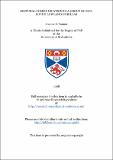Files in this item
Gestural communication in a group of zoo-living lowland gorillas
Item metadata
| dc.contributor.advisor | Byrne, Richard W. | |
| dc.contributor.author | Tanner, Joanne E. | |
| dc.coverage.spatial | 251 p. | en_US |
| dc.date.accessioned | 2018-07-09T08:58:54Z | |
| dc.date.available | 2018-07-09T08:58:54Z | |
| dc.date.issued | 1998 | |
| dc.identifier.uri | https://hdl.handle.net/10023/15088 | |
| dc.description.abstract | Gestural communication in a group of zoo-living lowland gorillas Videotaped observations of a group of zoo-living lowland gorillas collected over a seven- year period were used to study aspects of non-vocal communication. I discerned three classes of gesture: 1) tactile gestures, that depict motion paths iconically; 2) non-tactile silent gestures, some of which appear to be iconic and others deictic; and 3) audible gestures, that, unlike the other two classes, are species-typical gorilla behaviour. The iconic gestures appear to represent activities desired of another gorilla. In addition, one gorilla developed a gesture that was regularly used to suppress the playface, a facial expression that was presumably involuntary. Certain social and environmental conditions, such as the presence of competing males and a physical environment that permits female choice as to proximity with males, may promote the development of such forms of visual communication. I trace the development of gestures throughout the gorilla lifetime, and approach the acquisition of gestures from several viewpoints. "Ontogenic ritualization" and imitation are both found to have a limited explanatory value. One gorilla imitated human gestures, but there was no concrete evidence that these gorillas imitated each other. Repeated strings of gestures or other actions showed, however, that memory capacity exists in gorillas for reproducing complex sequences. Finally, I compare the gestural inventions of my zoo subjects with those of a gorilla taught American Sign Language, finding continuity in styles of depiction from portrayal of pure action to description of stationary objects. Gesture, in portraying action as well as in its ability to depict object shapes, can be seen as a necessary foundation for die eventual development of language in die hominid line. | en_US |
| dc.language.iso | en | en_US |
| dc.publisher | University of St Andrews | |
| dc.subject.lcc | QL737.P96T2 | |
| dc.subject.lcsh | Pongidae (Apes) | en |
| dc.title | Gestural communication in a group of zoo-living lowland gorillas | en_US |
| dc.type | Thesis | en_US |
| dc.type.qualificationlevel | Doctoral | en_US |
| dc.type.qualificationname | PhD Doctor of Philosophy | en_US |
| dc.publisher.institution | The University of St Andrews | en_US |
This item appears in the following Collection(s)
Items in the St Andrews Research Repository are protected by copyright, with all rights reserved, unless otherwise indicated.

